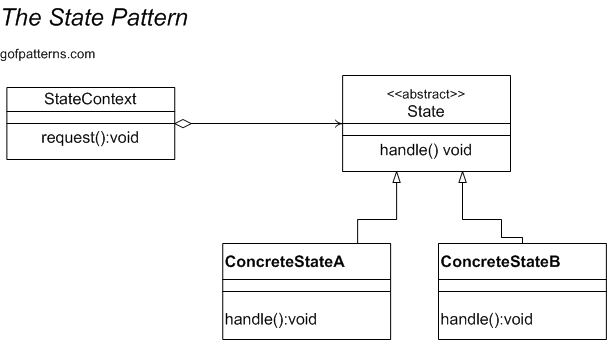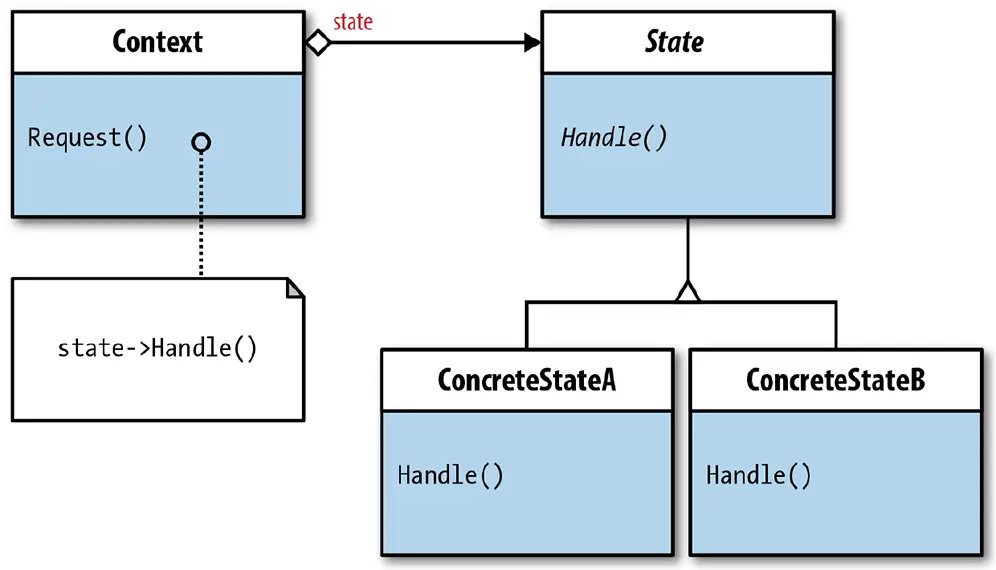The State Pattern: An In-depth Examination within Behavioral Design Patterns
In the vast landscape of behavioral design patterns, where interaction and responsibilities among objects are the primary focus, the State Pattern emerges as a paragon of dynamism and fluidity. It is crucial in providing a structured approach to object behaviors that change with their internal states.
- Understanding the Essence of the State Pattern: At its core, the State Pattern allows an object, often termed the 'Context', to modify its behavior when its internal state changes. Instead of implementing state-specific behavior within the object directly, this pattern offloads these behaviors to separate state objects. Thus, as the context’s state varies, different state objects are employed to dictate its behavior.
- Delineating the Components:
- Context: This is the primary entity whose behavior is contingent on its state. It maintains an instance of one of the state subclasses which defines its current behavior.
- State (Interface or Abstract Class): This defines a common interface for all concrete states, ensuring a consistent representation for the various states the context can assume.
- Concrete States: These subclasses of the State embody the actual behaviors corresponding to particular states of the context.
- Key Advantages Unveiled:
- Organized State Transitions: By externalizing state-specific behaviors to separate objects, transitions between states become more clear-cut and orderly.
- Enhanced Cohesion and Reduced Coupling: Each state class encapsulates the behavior for one state, adhering to the Single Responsibility Principle. This separation ensures that modifications to one state’s behavior do not inadvertently impact another.
- Dynamic Behavior Modification: The pattern allows for dynamic switching of behaviors at runtime, based on the state of the context.
- A Glimpse into Practical Scenarios:
Envision a media player with multiple playback states like 'Playing', 'Paused', and 'Stopped'. Instead of cluttering the media player with conditionals for each state, the State Pattern would enable each playback mode to be encapsulated within distinct state classes. As the user interacts with the player, changing its state, the corresponding state object dictates the player's behavior. - Position in Behavioral Patterns: Within the suite of behavioral patterns, the State Pattern specifically addresses scenarios where an object's behavior is a direct consequence of its state. Unlike the Strategy Pattern, which allows switching out algorithms or behaviors on the fly, the State Pattern is inherently tied to the phases or conditions an object goes through. It is about the evolution of an object's behavior over its lifecycle.
- Subtleties and Considerations: While the State Pattern is powerful, it can introduce numerous state classes, leading to increased complexity. It's pivotal to weigh this against the clarity and maintainability benefits the pattern offers. Moreover, the pattern's effectiveness is maximized when states are substantial and encapsulate meaningful behavior, rather than being mere status flags.
The State pattern allows an object to alter its behavior when its internal state changes. The object appears to change its class. The Figure illustrates the State Pattern.

Benefits of the State Pattern:
The following lists the benefits of using the State pattern:
- Localizes state-specific behavior and partitions behavior for different states .
- Make state transitions explicit.
When to Use the State Pattern:
You should use the State pattern when:
- An object's behavior depends on its state and it must change its behavior at run-time depending on that state.
- Operations have large conditional statements that consist of multiple states and depend on the object's state.
The State design pattern is one of the most useful patterns of those described within the Gang of Four. Games often depend on the State pattern because objects can change states so frequently in games. The purpose of the State pattern is to allow an object to change its behavior when the state changes. Many other simulations, whether they are games or not, depend on the State pattern as well. The Figure below shows the basic design pattern in a class diagram.

As shown, there is no Client class. However, the GoF book says that the Context is the primary interface for the clients. When examining the pattern, think of the Client class making its request through the Context class. There is a lot to understanding and effectively using the State design pattern, so for now, just take a quick look at the class diagram; the details will be unrolled gradually.